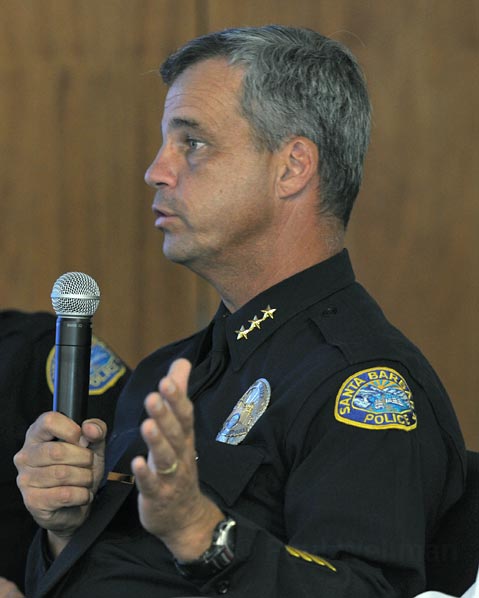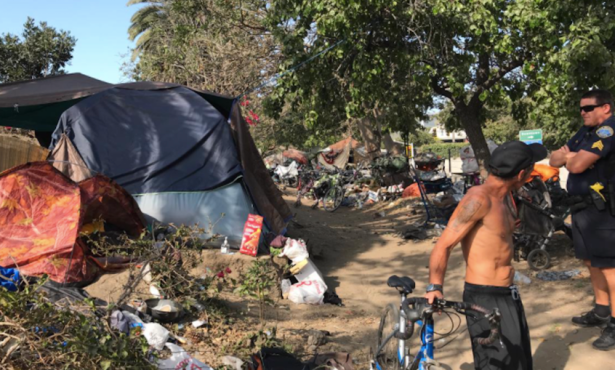Gang Injunctions to Be Filed Soon
City Attorney Expects 25 to 30 to Be Targeted
In a matter of weeks, the City of Santa Barbara is expected to file civil injunctions against 25 to 30 known adult gang members, which will bar them from associating with fellow gang members and setting foot in certain parts of town, as part of the city’s escalating enforcement effort in response to gang violence. This action marks a dramatic shift in city policy regarding gang injunctions, about which Police Chief Cam Sanchez has expressed significant reluctance and skepticism in the past. Even though the aggregate number of gang-related violent crimes has dropped notably in the last year — 14 percent — public anger and impatience with gang violence has decidedly increased. Two individuals with no gang affiliation were killed by gang members in the past year, one at Hendry’s Beach and another while walking home from work at a Milpas Street liquor store. The owner of a Chinese restaurant on Milpas Street was beaten on two occasions by gang members. And, most recently, a 47-year-old Eastside resident — described by police as “an innocent victim” — was stabbed multiple times last week by members of a Santa Barbara gang.

Assistant Police Chief Frank Mannix said the department began looking seriously at a gang injunction after Eastside gang members surrounded the Franklin Clinic a couple of years ago — forcing clinic employees to shut down and lock the doors — because they believed someone associated with a Westside gang was inside. Santa Barbara cops spoke with the Lompoc police officer who instigated that community’s gang injunction and heard positive, if decidedly anecdotal, reports. “We were told that after the injunction, gang members there were a lot less brazen,” Mannix recalled. “When you have brazen gang members, it tends to precipitate violence.” Likewise, Mannix said, the former chief of Oxnard’s police department said the injunction there proved effective. Santa Barbara, Mannix acknowledged, does not have anything close to Oxnard’s gang problems. “Compared to other communities, Santa Barbara has an enviable gang problem,” Mannix said. “But it’s a recurring problem.”
An injunction, he said, “is not a magic bullet. It won’t make the problem go away.” It will, he said, give law enforcement additional leverage in dealing with individual gang members. Mannix said many key details have yet to be worked out and that no date has been set for the first filing. But the only question around City Hall is when it happens — estimates range from two to four weeks — and under what conditions. No one interviewed for this story suggested it might not occur.
According to City Attorney Steve Wiley, an injunction will be filed against 25 to 30 of the city’s most serious gang offenders. It will not target gang members in general, he said, or people who dress a certain way. To qualify, Wiley said those targeted by the injunction have to have been convicted of crimes committed in furtherance of a street gang, known as “gang-related enhancements.” Or they must admit, he said, to being gang members. Those named will have an opportunity to defend themselves before a judge. But if the judge upholds the injunction, they will be barred from associating with other gang members. They will not be allowed to go to certain stores, parks, and areas in the city where gang violence tends to occur. While many specifics remain unresolved, Wiley did say that the injunction will not seek to impose curfew rules on those named. Those found in violation of the injunction, he said, would risk being found in criminal contempt of court, an offense that could land them in jail.
“A gang member is whoever the police say is a gang member,” she said. “Their burden of proof has been refined over the years,” she said, “but since no one really challenges these things, it’s a moot point.”
Cam Sanchez has been under significant pressure to embrace the gang injunction for several years. He’s taken considerable heat over his reluctance to do so. In 2007, he stated, “There are instances where a gang injunction does work, but in most cases it doesn’t.” Last year, he acknowledged his stance was shifting, explaining he’d been blistered by many in the Latino community for being too soft on gangs. But gang injunctions have been controversial from their inception. Civil libertarians object that injunctions effectively criminalize noncriminal behavior. “If someone commits a crime, fine, lock them up,” said Candace Carroll of the San Diego ACLU. “But to arrest someone for walking down the street with the wrong person?” (Wiley said the city’s injunction is modeled after one deployed in San Diego. Carroll litigated a major injunction case 10 years ago.) Because the gang injunction is a matter of civil law — as opposed to criminal — Candace pointed out, those filed against have no right to legal counsel. Many of the people named cannot afford a private attorney, she said, so most have no defense at all. She represented a client who she insisted had not been an active gang member in 10 years. “A gang member is whoever the police say is a gang member,” she said. “Their burden of proof has been refined over the years,” she said, “but since no one really challenges these things, it’s a moot point.” Although the injunction is a civil matter, failure to comply carries with it criminal penalties.
She acknowledged that neighborhoods where gang injunctions are deployed often experience a reduction in gang behavior. But that doesn’t mean it stops. “They just move somewhere else,” she said.
Gang injunctions can tax the resources of law enforcement agencies. Mannix estimated 2,000 hours have been spent working to prepare the research and analysis to support the city’s injunction. Some in law enforcement suggest those resources could be more effectively spent on more traditional anti-gang efforts. They point out that most serious offenders already have probation conditions that bar them from engaging in many of the behaviors covered in an injunction. Mannix countered that terms and conditions have time limits that injunctions do not. He said an injunction will prove far more effective than probation terms and conditions when dealing with a cluster of gang members on a street corner displaying a “what-are-you-going-to-do-about-it? attitude.”
One former gang member now working as a gang-intervention counselor expressed concern that an injunction would promote racial profiling. He expressed skepticism about claims made by proponents of the gang injunction that only “the baddest of the bad” would be targeted. They said the same thing in 1993 and 1994, he claimed, when the Legislature approved special gang-enhanced sentences. “Now they add enhancements any chance they get,” he said.
Dr. Gus Frias, recently hired to coordinate the many gang intervention and prevention programs on the South Coast, said he has not been notified about the gang injunction yet. He said injunctions can be useful but cautioned that gang-suppression efforts need to be balanced with intervention and education. As a practical matter, defense attorney Steve Balash — who represents many gang members — wondered how a gang injunction could work in a small town like Santa Barbara. “Some of the people I represent come from families that have been involved in gangs going back three generations. How does the injunction work when you’re in a gang, your brother’s in a gang, and your cousins are in a gang? Where can you go? Can you be with your family?” he asked. “I think it’s going to be very difficult to enforce.”
Mannix said many questions still need to be resolved before the first injunctions can be filed. City Hall will do its best to ensure the injunctions pass constitutional muster. As for ethnic profiling, he said gang violence falls disproportionately on poorer, Latino neighborhoods that need relief. “It’s criminal profiling, not racial profiling,” he said. In the final analysis, he said, these issues will be left up to a judge to decide.



